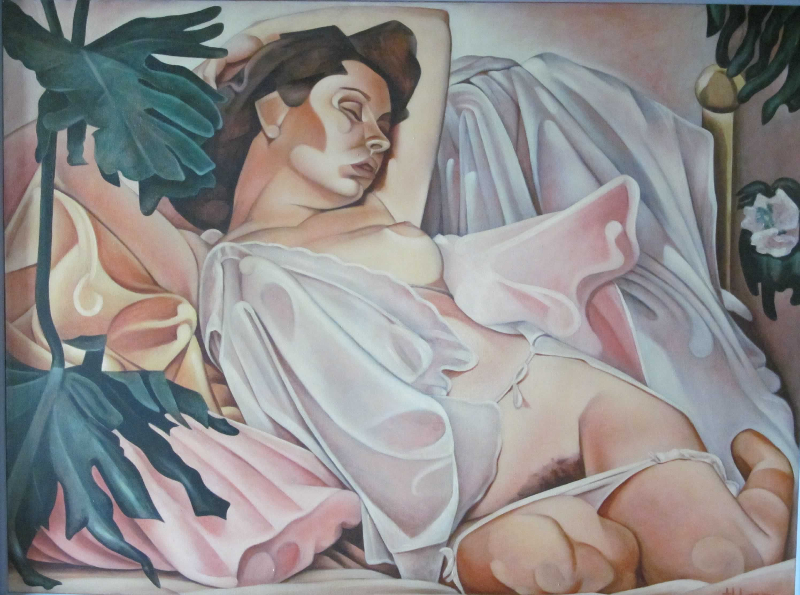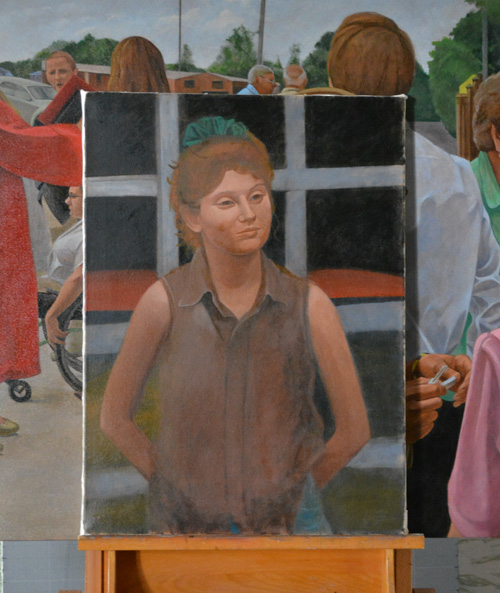
Old painting medium revisited
I’ve written before about my oil medium. I wasn’t exaggerating when I wrote that my medium, one I’ve used for years, is the result of many, many trials. I haven’t used every possible medium, of course, but I’ve tried a lot of them. No one can try all possible combinations. Recently, I revisited one of my earlier mediums, and I thought I’d share my experience.
I don’t believe there is one best medium or even one that was used universally during any period in history. It’s simple–and simplistic–to point out that the best medium is the one that suits your style. The real question is: how do you know that your medium suits your style? Have your tried others?
The majority of artists that I’m familiar with use the simplest medium–oil and turpentine. I guess that they consider its limitations the limitations of oil paint itself. If you’re happy with oil and turpentine alone, then more power to you. But, as you know, that medium was never widely used until recent times. If nothing else, artists modified their oil with the addition of driers, or by heating it to affect its performance.
A minority of artists are keenly interested in mediums, some to the point of obsession. These artists cook their varnishes, manipulate their oil in a variety of ways, and grind their paints. Some even press their oil. While some of these artists pursue the holy grail of mediums to compensate for artistic shortcomings, many, taking advantage of the tools of the information age, are doing important research. James Groves, an excellent painter, markets products that are the fruit of his research. I regularly use several of his products–copal varnish, and Courtrai drier.
My Early Practices
Like most young artists, I was indifferent toward mediums. I used oil and turp but soon became frustrated and started experimenting. I can’t remember everything I tried, but I used Venice turpentine, damar (yeech), stand oil, and others before settling on copal. I used several copal-based mediums, including some sold commercially. I remember one that had a pleasant citrus smell.
But several things made me dissatisfied with my copal-based medium. My results were inconsistent. I hadn’t learned yet how cynical manufacturers can be and what is sometimes marketed as copal might be of inferior quality, or not contain any copal at all. Plus I wasn’t experienced enough to appreciate the profound effect that the ground–or painting surface–has on painting. On some grounds, my medium performed as expected, but on others, it handled poorly. My inexperience led me to attribute the results to the medium instead of the ground.
Mastic Paintings
Maroger medium is a mastic-based medium that became my everyday medium for several years; I was introduced to it at The Art Students League in New York. Students and teachers alike used it. Each week, a vendor would sell out his supply of the homemade medium. The jelly-like medium was packaged in baby food jars with hand-written labels. Of course, I had to try it. The recipe was widely known, and soon I was preparing my own supply.
I still remember the recipe:
- I0 oz. turpentine
- 5 oz mastic tears
- 10 oz. cold-pressed linseed oil
- .5 teaspoon of litharge ( Litharge is sugar of lead. You can buy it at chemist suppliers or art suppliers.)
- Heat the oil.
- When the oil begins to boil, add the litharge and stir once(!).This prevents the oil from turning brown. If the litharge is cooked in the oil for a long period, it produces black oil.
- Using cheesecloth, strain the oil into a sturdy container.
- Pour the mastic into the oil, stir until dissolved then let cool.
- Add turp and stir.
- Pour mixture into small containers. Gels when cool.
When the medium cools, it forms a blonde, vaseline-like medium. I placed a bit of medium on my palette and mixed it into the paint as needed, thinning with turp as required.
By this point, I was aware of the inconsistent quality of art materials. It was important that I could control the ingredients and the quality of the medium by making it myself.
Maroger medium has several things to recommend it. Under the brush, it’s flowing and easy to blend and shade with. You can cover a lot of canvas quickly. Yet it also retains brushstrokes and makes crisp, sharp passages. Students and amateurs like it because it floats over the canvas and hides surface defects.
I’ve heard horror stories about maroger-made paintings–the paint cracking or peeling. Some of my maroger-based paintings are over 20 years old and show none of that. Paintings by older artists, such as Van Dyke who was known to use it or something similar, show none of these problems either. At least in none of the paintings I’ve examined. Having said that, mastic, a soft resin like Damar, is more prone to retain scratches and other insults than the harder resins–amber and copal.
Here is a painting, titled Nude, I did with my maroger medium.

I used maroger medium for some years. I stopped using it for two reasons:
- Due to its transparency, covering passages have to be thick, which results in an undesirable uniformity. I compensated by adding egg tempera and egg-oil emulsions, especially to the whites.
- Precise details are impossible. This is especially a problem in small paintings. I felt like I was wearing gloves or a condom. Soft or fuzzy details are fine, but I want the option to be precise.
Amber Varnish
After becoming increasingly dissatisfied with maroger, I began experimenting with mediums again. Amber varnish, which is the hardest resin, was considered a myth by many so-called experts. But shortly before I began my research, several vendors started offering it. As far as I am aware, amber varnish hadn’t been used for many years until it was reintroduced late in the last century. We now know artists routinely used it during and after the Renaissance.
Like maroger, amber varnish has much to recommend it. Not as flowing as maroger, it is still malleable and blends well. It’s OK for glazing but not as good as maroger because it starts to drag sooner. Fine details are possible.
I stopped using amber-based mediums because:
- Expense. Ridiculously expensive.
- Several paintings developed cracks. The cracked paintings were on wood so that it might be attributable to the wood. Other amber-based paintings on canvas have not cracked.
Here is a painting I did with an amber-based medium. You might not be able to see them in the reproduction, but cracks have appeared in the greens and darker background colors. Daryl is on a commercially-prepared wood panel. My guess is that the culprit isn’t the amber but the wood that wasn’t properly seasoned.

My Current Practice
I’ve written about my medium before, so I won’t repeat myself here. Follow the link at the beginning of the post if you want to learn about my current copal-based medium.
Maroger Revisited
Even though I still have the ingredients for my old maroger recipe, I don’t have any of the complete medium, and I don’t want to boil oil to just make a small batch. I do have ‘double mastic’ from the short-lived supplier Studio Products. ‘Double mastic’ (the name is a marketing gimmick) is simply mastic varnish, that is, a varnish made with turpentine and mastic. That’s exactly what my old recipe created as an intermediate step. I also have black oil. Black oil is linseed oil heated with litharge. Again, this is another intermediate item in my old recipe. The difference between my recipe’s oil and black oil is that black oil is cooked for a longer time (not just for a few moments). Litharge cooked in oil for a long time turns the oil dark; not black but a dark brown. Studio Products marketed maroger by selling black oil and double mastic separately, and users were instructed to mix the two as needed. Close to my old recipe.
So I mixed small amounts of black oil with double mastic varnish in equal measure and got a dark jelly-like medium. Not exactly like my old recipe, but close.
I will finish this painting with maroger but I will not be replacing my current medium, which I like better in every regard. I thinned the paint with thinner (not turp) and was able to get more variety in the covering passages, which was something I struggled with when using turp alone. It blends well, which I think you can see in this unfinished painting. Precise details are impossible with maroger so the medium fails. But because it covers easily and quickly, I might use it for really large-format paintings (5 feet and larger) where fine details are unimportant. But I’ll probably stick to my usual medium for the large-format paintings.
Archives
- June 2025
- April 2025
- March 2025
- February 2025
- January 2025
- December 2024
- November 2024
- October 2024
- September 2024
- August 2024
- July 2024
- June 2024
- May 2024
- April 2024
- March 2024
- February 2024
- December 2023
- November 2023
- October 2023
- September 2023
- July 2023
- June 2023
- May 2023
- April 2023
- March 2023
- February 2023
- January 2023
- December 2022
- November 2022
- October 2022
- September 2022
- August 2022
- July 2022
- June 2022
- May 2022
- April 2022
- March 2022
- February 2022
- January 2022
- December 2021
- November 2021
- October 2021
- September 2021
- August 2021
- July 2021
- June 2021
- May 2021
- April 2021
- March 2021
- February 2021
- January 2021
- December 2020
- November 2020
- October 2020
- September 2020
- August 2020
- July 2020
- June 2020
- May 2020
- April 2020
- March 2020
- February 2020
- January 2020
- December 2019
- November 2019
- October 2019
- September 2019
- August 2019
- July 2019
- June 2019
- May 2019
- April 2019
- March 2019
- February 2019
- January 2019
- December 2018
- October 2018
- September 2018
- August 2018
- July 2018
- June 2018
- May 2018
- April 2018
- March 2018
- February 2018
- January 2018
- December 2017
- November 2017
- October 2017
- September 2017
- August 2017
- July 2017
- June 2017
- May 2017
- April 2017
- March 2017
- February 2017
- January 2017
- December 2016
- November 2016
- October 2016
- September 2016
- August 2016
- July 2016
- June 2016
- May 2016
- April 2016
- March 2016
- February 2016
- January 2016
- December 2015
- November 2015
- October 2015
- September 2015
- August 2015
- July 2015
- June 2015
- May 2015
- April 2015
- March 2015
- February 2015
- January 2015
- December 2014
- November 2014
- October 2014
- September 2014
- August 2014
- July 2014
- June 2014
- May 2014
- April 2014
- March 2014
- February 2014
- January 2014
- December 2013
- November 2013
- October 2013
- September 2013
- August 2013
- July 2013
- June 2013
- May 2013
- April 2013
- March 2013
- February 2013
- January 2013
- December 2012
- November 2012
- October 2012
Categories
- aesthetics
- Amusement Park series
- anecdotes
- art boards
- Art history
- Art Museums
- Artists
- Bio
- Books
- cameras
- Cleveland
- computers
- Culture
- current affairs
- Drawings
- etching
- Fiction
- Galleries
- games
- Grumpy review
- How to
- Main Street
- materials
- Movies
- Paintings
- pen and ink
- Photography
- podcast
- Politics
- Reviews
- Shop Talk
- Studio Corner
- thomasparkerhudson.com
- Thumbs-Up-Down
- Tips and Studies
- Turpentine diaries
- Uncategorized
- Vermilion, OH
- video
- war
- writing
- YouTube

Leave a Reply